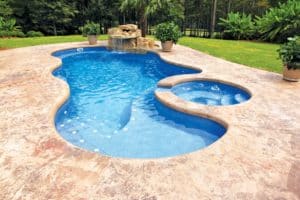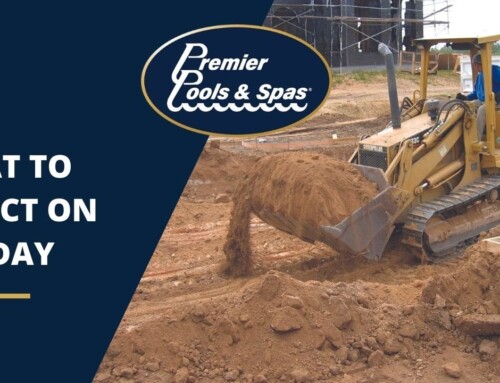Fiberglass pools are a popular choice for today’s homeowners. Durable and easy to care for, fiberglass swimming pools have many benefits, including lower maintenance costs and typically, a quicker build.
 From sea-inspired blues to the warmest bronze, there’s a pool color, size, and style for every home.
From sea-inspired blues to the warmest bronze, there’s a pool color, size, and style for every home.
Want to know what is so phenomenal about fiberglass pools? First, you should understand exactly what fiberglass is.
What is Fiberglass?
When one thinks of fiberglass, typically the vision involved the familiar, fluffy pink insulation that lines attics. However, that is only part of the history of fiberglass.
Owens Corning Company trademarked the recognizable Pepto-colored insulation product known as Fiberglass, however, fiberglass has a wide variety of uses.
Fiberglass really is made of glass. It is similar in structure to windows or kitchen drinking glasses. To manufacture fiberglass, glass is heated until molten, then forced through superfine holes. This creates glass filaments that are extremely thin—so thin, in fact, that they are measured in microns.
These flexible threads can be used in several applications: They can be woven into larger swatches of material or left in a somewhat less structured form utilized for insulation or soundproofing.
The final application is dependent on the length of the extruded strands (longer or shorter) and the quality of the remaining particles.
Once the fiberglass is woven together, resin is added to give the product increased strength. This results in a composite that can be molded into various shapes. Common items made of fiberglass include bathtubs, surfboards, sporting equipment, roofing, and, of course, swimming pools and spas.
Fiberglass also has numerous custom-made applications designed to suit specific purposes. For example, custom car parts made to replace damaged components for existing automobiles can be constructed with fiberglass.
How are Fiberglass Pools Constructed?
Fiberglass pool manufacturing is a 9-step process. Before the process starts, a pool mold is selected. Fiberglass pool molds come in many shapes and sizes. Once the mold is selected, the pool manufacturing process begins:
- Gelcoat is sprayed onto the selected fiberglass pool mold. Gelcoat comes in an array of colors, so your fiberglass pool will have its own unique appearance. This Gelcoat is applied in three separate passes, to achieve a strong gel finish
- Vinyl ester resin is applied behind the Gelcoat, for corrosion resistance.
- Chopped fiberglass and woven roving are applied using a mixture of polyester resin that is infused with ceramic microspheres, for strength and durability
- A fabric containing both carbon and Kevlar fibers is added to the next layer, specifically at stress points for added strength.
- Structural honeycomb materials, also known as vertical ribs or reinforcements, are added to increase the strength and stiffness of the pool walls.
- The fiberglass pool shell is cured
- The new shell is removed from the mold.
- Excess fiberglass is trimmed from the mold.
- The fiberglass pool shell is inspected to ensure it’s ready for shipment
Once steps 1-9 are complete, the pool will make its way to a delivery truck and is sent to its new home. While fiberglass pool building may seem daunting, most homeowners can enjoy their new inground fiberglass pool in just a few days, compared to several months needed to build a gunite pool.
 Is a Fiberglass Pool the Right Choice for You?
Is a Fiberglass Pool the Right Choice for You?
Choose a fiberglass swimming pool if you want a beautiful pool that is low maintenance, and you want your pool built in a short time frame. For more information on fiberglass pools, visit our inground fiberglass pool page, or contact Premier Pools & Spas. We’re here to answer your questions and supply a free quote.



